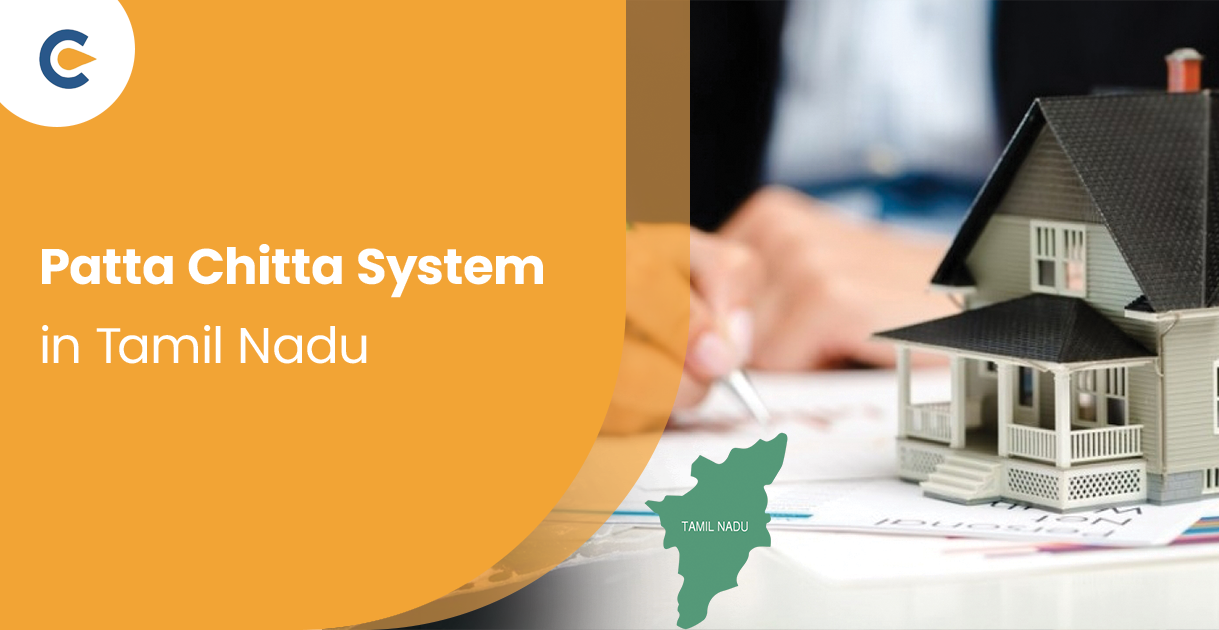In the Indian state of Tamil Nadu, Pattas and Chittas are essential land records that play a crucial role in establishing property ownership and managing revenue. A patta is an official document that identifies the legal owner of a piece of land. It contains important information such as the ownership details, survey numbers, and the amount of revenue associated with the property.
On the other hand, a chitta is a land revenue record that includes information about the land’s area, classification, and various aspects related to revenue collection.
The government of Tamil Nadu introduced the Patta Chitta system to ensure efficiency and transparency in land transactions by streamlining and digitizing land records. These documents are crucial for buying or selling land, obtaining loans, and accessing other government services. The digitization of Patta Chitta records has simplified the process of verifying land ownership and reduced the possibility of fraudulent transactions.
Citizens can now access their Patta Chitta records online through the official website, making it easier to update and verify land-related information. The Patta Chitta system in Tamil Nadu facilitates efficient property management and land administration while promoting transparency in land transactions.
Significance of Patta Chitta TN
In the state of Tamil Nadu, the Patta Chitta system is essential for Property Ownership and Revenue Management. It also plays a crucial role in Real Estate transactions and government-related procedures. The official document known as a patta is used to identify the owner of a specific piece of land. It includes information such as the property’s location, the owner’s name, Tax details, and survey number. This document is necessary for establishing Ownership Rights, Securing Loans, and accessing various Government services.
On the other hand, a Chitta is a land revenue record that contains information about the area, classification, and other aspects related to revenue. The government uses this record to assist in assessing and collecting land revenue. Both Patta and Chitta documents are essential to ensure the legitimacy and transparency of land transactions.
The digitisation of Patta Chitta records has transformed the land administration system in Tamil Nadu. Citizens can now easily access and verify their property records online, reducing the need for physical documents and minimizing the potential for fraudulent activities. Landowners can review and update their information using the online portal, which streamlines the process of land-related transactions.
Patta Chitta System for Streamlining the Verification Process
One of the many crucial benefits of the Patta Chitta system is its ability to streamline the verification process for potential buyers and financial institutions. Before engaging in land transactions or granting loans, stakeholders can quickly and easily verify the legitimacy of the land title online.
Furthermore, Patta Chitta records are essential for accessing a variety of government services and benefits associated with Land Ownership. Government initiatives and subsidies typically require verified land records, and the Patta Chitta system ensures that citizens can easily access and provide accurate information when needed.
Finally, it is important to note that the Patta Chitta system in Tamil Nadu is vital for establishing and verifying Land Ownership, enabling transparent property transactions, and facilitating efficient land administration and revenue collection processes. The digitisation of these records has certainly streamlined the process and improved their accessibility and security for the benefit of Stakeholders and Landowners alike.
Different Types of Patta
There are several types of patta, each serving a specific purpose:


- Natham Patta: This type of Patta is granted to individuals who do not own a house in their revenue village. It provides them with the legal right to occupy and utilise the land allocated to them.
- AD Condition Patta: The circular Adithravidar Nalan Dasildar is responsible for allocating land to landless tribals and Adithravidars. The patta is signed by the individual governor and includes a photograph of the patta holder. It ensures that the land is allocated to the rightful beneficiaries.
- Land Handover Patta: The government provides free land to certain groups, such as ex-servicemen and economically disadvantaged individuals from backward classes. This type of Patta is known as the land handover belt, and it helps to promote Social Welfare and Economic Development.
- TSLR Patta: The Town Survey Land Record (TSLR) document is a type of patta that pertains to land records in urban areas. It contains essential information about the land, such as its location, boundaries, and Ownership details.
- Other types of Patta:
- UDR (Updating Data Registry) Patta: This Patta is issued when land records are updated or revised to reflect changes in Ownership or other relevant details.
- Manual Patta: As the name suggests, this type of Patta is issued manually and is not digitized.
- 2C Patta: This Patta is issued for land that is classified as “2C” land, which is land that has been converted from Agricultural to Non-agricultural use.
- Joint Patta: When multiple individuals jointly own a piece of land, a Joint Patta is issued, listing all the owners’ names and their respective shares in the Property.
Step-by-step Guide to Apply for Patta Chitta in Tamil Nadu
The Steps to be followed to apply for Patta Chitta in Tamil Nadu are as follows:
- Access the Official Portal: Navigate to the Tamil Nadu Land Records e-Services official website at eservices.tn.gov.in. This portal serves as a centralized platform for accessing various land-related services, including Patta Chitta records.
- Select the Appropriate Option: Once you are on the website, locate and click on the “View Patta & FMB/Chitta/TSLR Extract” option. This will direct you to the specific section where you can retrieve the desired land records.
- Choose the District and Taluk: From the provided dropdown menus, select the District and Taluk where the land in question is situated. This step helps narrow down the search to the relevant administrative divisions.
- Input the Required Information: Fill in the necessary details about the land, such as the survey number, village name, taluk, and district. Providing accurate information is crucial for retrieving the correct Patta Chitta records.
- Confirm the Entered Details: Before submitting your request, carefully review the information you have entered to ensure its accuracy. Once you have verified the details, proceed to submit the form.
- Verify Your Identity via Mobile Number: As a security measure, you will be asked to provide your mobile number for authentication purposes. The system will send a unique One-Time Password (OTP) to the registered mobile number, which you must enter to validate your identity and proceed further.
- Access the Patta Chitta Document: Once you have successfully authenticated your identity using the OTP, you will be granted access to view and download the Patta Chitta document. This document contains crucial information about the land, including Ownership details, revenue records, and other relevant particulars.
- Complete Payment (if Required): In some cases, there may be a nominal fee associated with obtaining the Patta Chitta document. If applicable, you will be directed to make the necessary payment online using secure payment gateways. This ensures a seamless and hassle-free process for accessing the land records.
- Obtain a Printout for Your Records: After successfully completing the authentication process and making the payment (if required), you will have the option to print the Patta Chitta document. It is advisable to keep a physical copy of the document for your records and future reference.
Documents Required for Patta Chitta Application
The specific documents required for obtaining a Patta Chitta in Tamil Nadu may vary slightly based on the nature of the application or land transaction. However, the following documents are generally necessary for a standard application:
- Proof of Identity: Applicants must provide a valid government-issued identification document, such as an Aadhaar card, passport, or driver’s license, to establish their identity. This helps prevent fraudulent applications and ensures that the Patta Chitta is issued to the rightful owner.
- Proof of Address: A document verifying the applicant’s current address, such as a Utility Bill, Bank Statement, or Voter ID card, is required. This helps authenticate the applicant’s residential details and ensures that the Patta Chitta is linked to the correct address.
- Land Ownership Papers: The existing Land Ownership Documents, such as Sale Deeds, Gift Deeds, or Inheritance Papers, must be submitted to prove the applicant’s legal rights over the Property. These documents establish the chain of Ownership and support the applicant’s claim to the land.
- Encumbrance Certificate: An Encumbrance Certificate can be obtained from the Sub-Registrar’s Office which is necessary to confirm that the land is free from any Legal Disputes, Mortgages, or other Encumbrances. This Certificate ensures that the Patta Chitta is issued for a clear and unencumbered Property.
- Record of Rights (ROR): The ROR is a document that provides details about the land, including the owner’s name, the land’s dimensions, and any registered Rights or Interests. It serves as an essential reference for verifying the land’s status and Ownership.
- Land Tax Receipts: Applicants must submit receipts proving that they have paid the necessary Land Taxes. These receipts demonstrate that the owner has fulfilled their tax obligations and that the land is in good standing with the revenue department.
- Survey Number and Subdivision Details: The Land’s survey number and subdivision details, as recorded in the revenue records, must be provided. This information helps identify the specific plot of land for which the Patta Chitta is being sought.
- Old Patta or Chitta Documents: If the land has previously been issued a Patta or Chitta, the old Documents should be submitted along with the application. These Documents provide a historical record of the land’s ownership and help establish continuity.
- Mutation Register Extract: An extract from the mutation register, which records changes in Land Ownership, is required to show the current ownership status of the land. This Document ensures that the Patta Chitta reflects the most up-to-date Ownership information.
- Copy of Layout Approval: If the land is part of an approved layout, a copy of the layout approval must be submitted. This Document confirms that the land has been legally subdivided and is suitable for individual Ownership.
- Power of Attorney: In cases where the applicant is acting on behalf of the Land Owner, a Registered Power of Attorney must be provided. This Document authorizes the applicant to represent the owner and carry out the necessary procedures for obtaining the Patta Chitta.
By gathering and submitting these documents, applicants can ensure a smooth and successful process for obtaining a Patta Chitta in Tamil Nadu. The specific requirements may vary based on the nature of the application, but these documents form the core of most Patta Chitta applications.
Fee Structure for Obtaining Patta Chitta in Tamil Nadu
The Tamil Nadu government has made significant progress in digitizing land records, making the Patta Document accessible online for a nominal fee of Rs. 100. This initiative aims to provide citizens with easy access to crucial information about Land Ownership and details.
The Patta Chitta Documents play a vital role for farmers, as they serve as proof of Land Ownership when seeking crop loans from banks and other financial institutions. By obtaining these loans, farmers can ensure timely payment of their Land Revenue Taxes.
In addition to the application fees for Patta and Chitta, there are several other charges associated with obtaining the Patta Chitta in Tamil Nadu, which include the following:
- Patta Application Fee: This fee is levied when an individual applies for a new Patta document or requests changes to an existing one.
- Chitta Application Fee: Similar to the Patta Application Fee, this charge is applicable when seeking a new Chitta document or modifying an existing record.
- Combined Patta Chitta Fee: When an applicant requests both the Patta and Chitta documents together, a consolidated fee is charged.
- Online Service Charges: As the Patta Chitta documents are now available online, a small service charge is levied to cover the costs associated with maintaining and updating the digital infrastructure.
- Other Charges: Depending on the specific nature of the application or the additional services required, there may be other miscellaneous charges involved in the process of obtaining the Patta Chitta.
By making land records readily available online and establishing a transparent fee structure, the Tamil Nadu government has taken a significant step towards empowering citizens and streamlining the process of accessing vital land-related documents. This initiative not only benefits individual landowners but also supports farmers in securing the necessary financial assistance for their agricultural activities.
Step-by-step Guide to Transferring Patta Chitta Land Records
To transfer Patta Chitta records in Tamil Nadu, the steps mentioned below need to be followed:
- Secure an attested copy of the Sale Deed: Obtain a certified copy of the Sale Deed from the concerned authorities. This document serves as proof of the transfer of ownership and is a crucial requirement in the Patta Chitta transfer process.
- Verify and update the mutation entry at the Tahsildar office: Visit the local Tahsildar office and ensure that the mutation entry, which records the change in ownership, is accurate and up to date. This step is essential to align the land records with the current ownership status.
- Submit the Patta transfer application along with the required documents: Prepare and submit a Patta transfer application to the Tahsildar office, accompanied by all the necessary supporting documents. These may include the sale deed, identity proof, address proof, and other relevant paperwork as specified by the authorities.
- Remit the applicable charges for the transfer process: Pay the prescribed fees associated with the Patta Chitta transfer process. These charges may vary depending on factors such as the land’s value, the nature of the transfer, and administrative costs.
- The Tahsildar office will scrutinise the documents and process the transfer: Upon receiving the application and supporting documents, the Tahsildar office will carefully examine the paperwork to ensure its completeness and accuracy. They will then initiate the transfer process, updating the Patta Chitta records to reflect the new ownership.
- Once approved, the updated Patta Chitta records will reflect the new owner’s details: After the transfer is approved, the Patta Chitta records will be updated to include the new owner’s information. These updated records can be accessed online through the designated portal for easy reference and verification.
For any clarifications or assistance regarding the specific regulations and procedures related to Patta Chitta transfers, it is advisable to consult the local revenue office. They can provide guidance and help navigate the process smoothly.
By following the above-mentioned steps and working closely with the relevant authorities, individuals can successfully transfer Patta Chitta records to Tamil Nadu, ensuring that the land records accurately reflect the current ownership status.
The Final Words
In conclusion, the introduction of the Patta Chitta system in Tamil Nadu represents a significant milestone in land administration, offering citizens a user-friendly and transparent interface for managing and verifying land-related information. Apart from facilitating easier access to land records, the digitization of these documents has substantially reduced the scope for fraudulent activities.
The online availability of Patta Chitta records streamlines property transactions, enhances ease of verification, and contributes to a more transparent framework for land governance.
By providing a comprehensive view of land ownership and revenue details, Patta Chitta ensures the authenticity and legitimacy of land titles, enabling informed decision-making in real estate dealings.
Frequently Asked Questions
How do I check Patta Chitta online status?
Simply log on to the official website https://edistricts.tn.gov.in/revenue_report/status.html and check the status of Chitta Patta online after you input the details.
What is the fee to get Patta Chitta online?
You have to pay a nominal amount of Rs 100/- for the Patta Chitta record.
Who issues the patta?
Patta is issued by the Tamil Nadu government. It can be obtained from the tahsildar's office of the specific district.
What is the Patta Chitta customer care number?
A customer feedback ID has been created and you can send your feedback to eservices@tn.nic.in.
How to locate the nearest Taluk office for Patta Chitta work?
One can locate the nearest Taluk office simply by asking other locals or visiting the district headquarters. The district headquarters would then provide the individual with the address of the nearest Taluk office.
What is Adangal in Tamil Nadu?
Adangal is the revenue record that includes land-related details such as ownership, area, nature of possession of the land, liabilities, tenancy, crops grown, etc. The document has the survey number of the land.
What is TSLR extract?
The full form of TSLR is Town Survey Land Record which refers to the revenue land records for land in Tamil Nadu, also called as field extracts. These are municipal and town area equivalents of Patta.
What is an A-register?
A-register is the land record maintained at the office of VAO (Village Administrative Officer) in the state. It contains property-related details, including classification, owner's name, and tax assessment. etc.
How to download the Patta Chitta mobile app?
Visit the Google Play store on your smartphone. Search for the Amma e-service of the Land Records mobile application. Install the application. Once installed, go to the application to find Patta Chitta details on your mobile.
Read our article PICME Registration: Eligibility, Benefits, And Procedure











